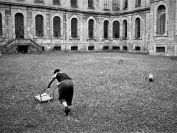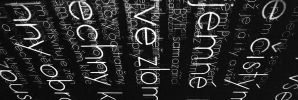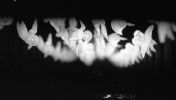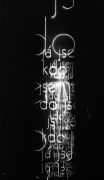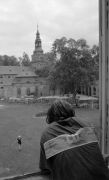Zuzana Füsterová graduated from the Academy of Fine Arts in the mid-1990s. While she was studying at AVU, she began experimenting with light boxes, which she exhibited in complete darkness. Each light box is made up of a black glass layer that is covered in letters or hermetic symbols (e.g., The Sephirotic Tree). Mirrors are placed in the box, which the viewer cannot see, and which multiply the image to infinity. The resulting patterns of light change with the viewer’s angle of view. In these works the artist comes close to the tunnel concept of the sensory evocation of transcendence. We stand before a world of archetypal spaces dominated by feelings of ambiguity, elusiveness, variability and the non-definable.
In recent years, Füsterová’s interest in the phenomenon of darkness has led her to an expressive experience of deep darkness: a week spent in complete isolation and total darkness in a single room. The archetypal experience of vast emptiness in absolute darkness was a profound experience for her. One thing she learned was that you begin to see pictures and visions in the dark, while questions such as, Who am I? What is man? What is the world? and What is thought? take on an urgent presence.
This mystical immersion in a psycho-spiritual “other world” is characteristic of Füsterová’s later work, as well. This includes paintings created from 2001 onwards. These are images that are created through a long process of the application of colours in several (sometimes up to ten) layers. The artist applies a thin smear of acrylic paint on a soaked canvas. She then reorients the canvas and allows the paint to trickle. She wipes away the paint and applies further layers using a spray gun filled with light paint or plain water. The results are abstract images which are not, however, simply a game played with forms. Her paintings are reminiscent of the world of Mark Rothko, and they are not simply compositions of coloured surfaces but the expression of deeper spiritual meanings. Rothko’s simple coloured compositions give the impression that they contain a specific and profound truth, as though they were the consequence of long, arduous mediation. Rothko’s canvases, lacking specific forms, represent the true lesson of abstract expressionism, a direct response to the unfathomable mystery of the human soul. Füsterová takes up this theme in her paintings, of which she says: “I am concerned with washing and emptying, disengaging from any content and imagination. The images remain simply a kind of veil of something that no longer exists and remains empty.” She draws here on her experience of the dark and her solitude within it, a black solitude in which the space is experienced with the body and through sensory deprivation.
Füsterová’s life and work is inspired by archetypal emotions and experiences that lead to a spiritual understanding of the world. Her work appears to be insulated from the context of prevailing conceptual tendencies, though within the context of the development of 20th century art it has its unique place and a worthy status within the development of 21st century art, as well.
Ivona Raimanová
